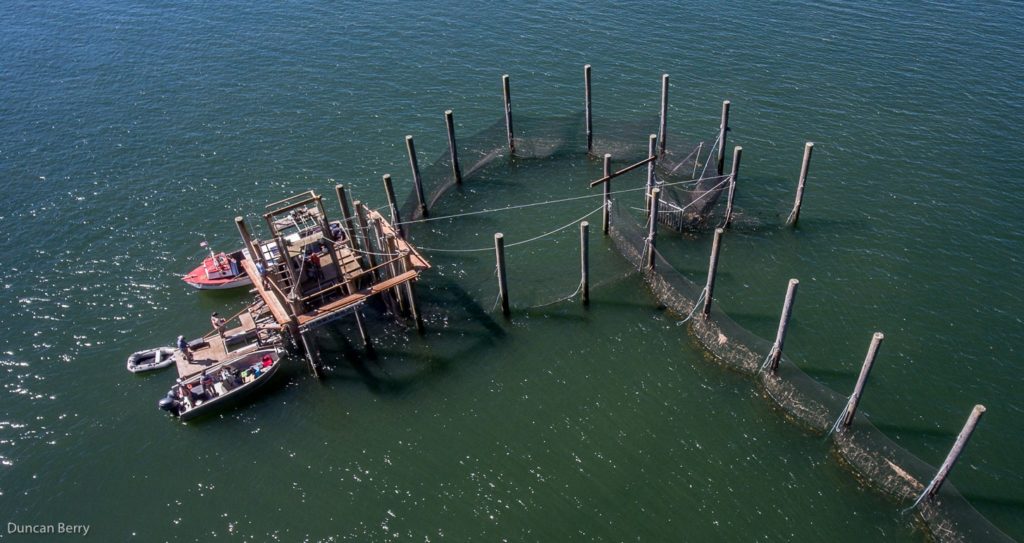Washington state is taking an historic step forward to legalize fish traps for sustainable commercial fishing on the Columbia River. This week, Washington Department of Fish and Wildlife (WDFW) Director Kelly Susewind officially announced the agency will designate an Emerging Commercial Fishery for alternative commercial fishing gear that will legalize fish traps. This decision will finally allow commercial fishers who strive to fish sustainably the choice to use contemporary fish traps as an alternative to gill nets in the lower Columbia River.
“This is a truly momentous win-win for wild fish, orcas, fishers, and coastal economies alike” said Kurt Beardslee, Director of Wild Fish Conservancy. “The benefits of this decision will be felt for generations throughout the Columbia River basin and beyond.”
In 1934, legislators banned fish traps and many other methods of salmon fishing in Washington State, making the gill net the only legal method of commercial salmon fishing in the lower Columbia River and elsewhere. This 87-year-old political decision has shaped management of the state’s salmon fisheries to this day.
Under current management of lower Columbia River salmon fisheries, the gill net is the only tool available for mixed-stock commercial harvest of salmon. Fisheries managers attempt to direct harvest efforts toward hatchery produced salmon; however, gill nets inevitably entangle federally protected wild fish that co-mingle in the fishery. This results in direct and indirect mortality of wild fish listed under the Endangered Species Act, reducing the effectiveness of wild salmonid recovery efforts and constraining fishing opportunities.
“Under the status-quo, everyone is losing. Federally protected salmon are being harvested, orcas that depend on healthy salmon runs are continuing to starve, fishing opportunities are being constrained, and coastal economies are struggling,” says Kurt Beardslee, Wild Fish Conservancy Director. “By investing in the development of fishing techniques that can reduce or nearly eliminate impacts to threatened wild fish while allowing for selective harvest of hatchery stocks, we are charting a new path forward for a sustainable and resilient fishery that will benefit wild fish, orcas, and generations to come.”
The decision to legalize fish traps was informed by over half a decade of successful research by Wild Fish Conservancy biologists in collaboration with commercial fishers, processors, and state and federal government officials to evaluate the potential of fish traps to operate as a sustainable commercial fishing tool that can aid wild salmon recovery and help revitalize coastal economies.

This research, published in prominent fisheries management journals, demonstrates the unique ability of fish traps to reduce bycatch mortality in commercial salmon fisheries. Utilizing a passive technique that addresses problems associated with conventional fishing gears, including net entanglement, human handling, air exposure, and overcrowding, fish traps enable release of wild salmon and steelhead with survival rates that range from 94% to 100% (Tuohy et al. 2019; Tuohy et al. 2020). Hatchery stocks produced for fisheries are selectively harvested for market, preventing the domesticated fishes from reaching spawning grounds where they compete with and harm the genetics of wild fish.
“Across the board, the fish trap appears to be the most promising tool available for capturing hatchery fishes for harvest while releasing wild salmon and steelhead mostly unharmed. What we’ve seen so far is just the tip of the iceberg—each year there are further improvements to the fishing gear that are reducing bycatch mortality effects, and I expect to see increased capture efficiency as well,” said Adrian Tuohy, Biologist with Wild Fish Conservancy.
The Emerging Commercial Fishery announced by the agency this week will legalize the commercial use of fish traps at a localized-scale in the lower Columbia, allowing this promising gear to further improve as research continues, and demonstrate its potential as a sustainable, selective harvest and monitoring tool. The designation process begins with a rulemaking process that will lay the groundwork for the future fishery and develop a plan to support commercial fishers interested in transitioning.
“This decision by Director Susewind makes a lot of sense. Finally, there are multiple tools in the toolbox, allowing fishers and resource managers to adapt to the realities of the Endangered Species Act and the many unknown challenges of tomorrow,” said Tuohy.
Thank you to everyone who voiced their support and helped make this enormous success possible!

Join our mailing list to recieve important updates on our work, the latest wild fish news, & opportunities to take action to support wild fish.
This site is protected by reCAPTCHA and the Google Privacy Policy and Terms of Service apply.
Wild Fish Conservancy is recognized as a 501(c)3 non-profit by the IRS